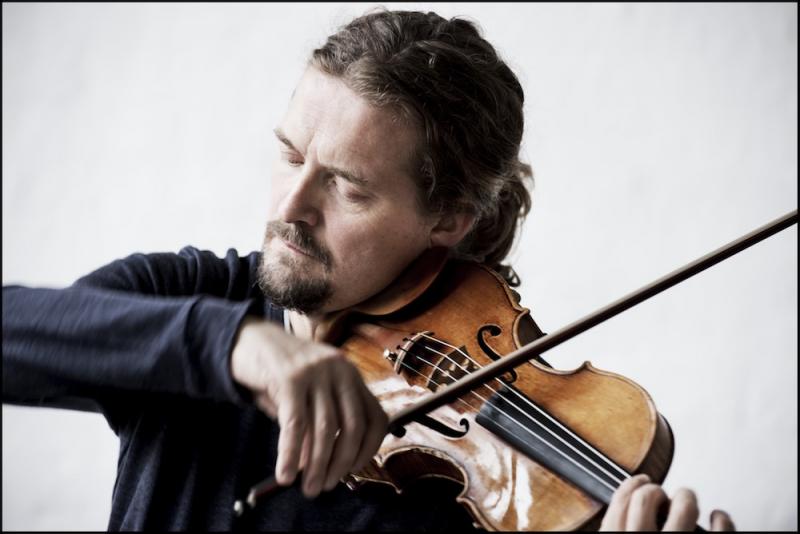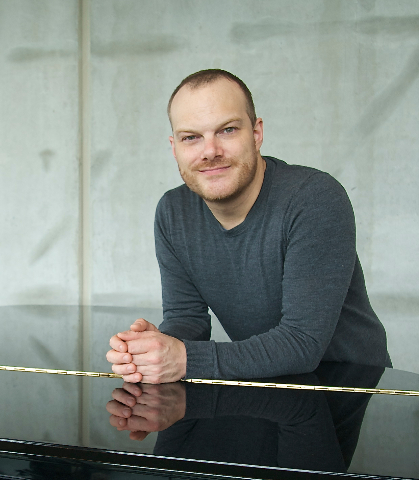Christian Tetzlaff, Lars Vogt, Wigmore Hall review - lyrical Brahms from veteran duo | reviews, news & interviews
Christian Tetzlaff, Lars Vogt, Wigmore Hall review - lyrical Brahms from veteran duo
Christian Tetzlaff, Lars Vogt, Wigmore Hall review - lyrical Brahms from veteran duo
The great German's three violin sonatas shine in elegant and songful readings

Sonata no 1 – Sonata no 2 – Sonata no 3 – that’s barely a recital programme, it’s just a list. Fortunately, violinist Christian Tetzlaff and pianist Lars Vogt (pictured below by Neda Navae) have good musical reasons for presenting the Brahms violin sonatas in chronological order.
Tetzlaff and Vogt have a long acquaintance with the Brahms sonatas. They first recorded them together in 2002, and have since made a second recording, released to much acclaim last year. Predictably then, their performance here was technically flawless, with the two players closely aligned in every aspect of interpretation. But there was never any sense of routine, and Tetzlaff’s ability to breathe life into each of Brahms’s songful melodies was matched by Vogt’s subtle harmonic shifts and gently rolling accompaniment textures.
 These were measured readings, carefully paced so that the steady tempos afforded repose rather imposing grandeur. Tetzlaff’s performed each movement of the First Sonata as if it were an unbroken, sinuous melody. There was little sense of architecture, and very little contrast between themes. Even the concluding cadences to each of the movements were downplayed for continuity. The Second Sonata was presented with slightly more rhythmic definition, the piano’s offbeat interjections imposing a greater sense of momentum to the opening movement. Tetzlaff responded by adding slightly edge to his attacks, though still retaining his absolute evenness of tone.
These were measured readings, carefully paced so that the steady tempos afforded repose rather imposing grandeur. Tetzlaff’s performed each movement of the First Sonata as if it were an unbroken, sinuous melody. There was little sense of architecture, and very little contrast between themes. Even the concluding cadences to each of the movements were downplayed for continuity. The Second Sonata was presented with slightly more rhythmic definition, the piano’s offbeat interjections imposing a greater sense of momentum to the opening movement. Tetzlaff responded by adding slightly edge to his attacks, though still retaining his absolute evenness of tone.
The greater drama of the Third Sonata highlighted subtle contrasts between the two instruments. Tetzlaff’s tone isn’t broad. He plays a modern violin, which projects a sweet but narrow voice. His use of vibrato is reserved, an occasional and carefully applied colouring to an otherwise direct and uncomplicated sonority. Vogt gets on well with the Wigmore Hall Steinway, producing a similarly well-judged tone, but usually tending towards warmth and richness, the contrast with Tetzlaff’s drier tone all the more marked as the dynamics increase.
The four movements of the Third Sonata each highlighted a different quality of the two players’ interaction. Complex rhythms underpin the first movement, but sounded clear and unambiguous here. The slow second movement was again presented by Tetzlaff as a single, uninterrupted line, but more declamatory now, and with Vogt following suit. The scherzo third brings the two instruments into complex rhythmic interaction, but even when Brahms sets one player against the other, they still play as one. And in the rousing finale, the two players finally broke free of their earlier reserve for a propulsive tarantella. The change of pace was welcome, with weighty attacks from both combining with the faster tempo to bring drive and focus. But even here, the primary qualities were evenness of tone – Tetzlaff reaching into the higher registers and proving just as solid there - and unity of intent, the sense of shared conviction driving the music right up to the very last bar of the score.
rating
Share this article
The future of Arts Journalism
You can stop theartsdesk.com closing!
We urgently need financing to survive. Our fundraising drive has thus far raised £49,000 but we need to reach £100,000 or we will be forced to close. Please contribute here: https://gofund.me/c3f6033d
And if you can forward this information to anyone who might assist, we’d be grateful.

Subscribe to theartsdesk.com
Thank you for continuing to read our work on theartsdesk.com. For unlimited access to every article in its entirety, including our archive of more than 15,000 pieces, we're asking for £5 per month or £40 per year. We feel it's a very good deal, and hope you do too.
To take a subscription now simply click here.
And if you're looking for that extra gift for a friend or family member, why not treat them to a theartsdesk.com gift subscription?
more Classical music
 Hallé John Adams festival, Bridgewater Hall / RNCM, Manchester review - standing ovations for today's music
From 1980 to 2025 with the West Coast’s pied piper and his eager following
Hallé John Adams festival, Bridgewater Hall / RNCM, Manchester review - standing ovations for today's music
From 1980 to 2025 with the West Coast’s pied piper and his eager following
 Kaploukhii, Greenwich Chamber Orchestra, Cutts, St James's Piccadilly review - promising young pianist
A robust and assertive Beethoven concerto suggests a player to follow
Kaploukhii, Greenwich Chamber Orchestra, Cutts, St James's Piccadilly review - promising young pianist
A robust and assertive Beethoven concerto suggests a player to follow
 Robin Holloway: Music's Odyssey review - lessons in composition
Broad and idiosyncratic survey of classical music is insightful but slightly indigestible
Robin Holloway: Music's Odyssey review - lessons in composition
Broad and idiosyncratic survey of classical music is insightful but slightly indigestible
 Classical CDs: Wolf-pelts, clowns and social realism
British ballet scores, 19th century cello works and contemporary piano etudes
Classical CDs: Wolf-pelts, clowns and social realism
British ballet scores, 19th century cello works and contemporary piano etudes
 Bizet in 150th anniversary year: rich and rare French offerings from Palazzetto Bru Zane
Specialists in French romantic music unveil a treasure trove both live and on disc
Bizet in 150th anniversary year: rich and rare French offerings from Palazzetto Bru Zane
Specialists in French romantic music unveil a treasure trove both live and on disc
 Scottish Chamber Orchestra, Ibragimova, Queen’s Hall, Edinburgh review - rarities, novelties and drumrolls
A pity the SCO didn't pick a better showcase for a shining guest artist
Scottish Chamber Orchestra, Ibragimova, Queen’s Hall, Edinburgh review - rarities, novelties and drumrolls
A pity the SCO didn't pick a better showcase for a shining guest artist
 Kilsby, Parkes, Sinfonia of London, Wilson, Barbican review - string things zing and sing in expert hands
British masterpieces for strings plus other-worldly tenor and horn - and a muscular rarity
Kilsby, Parkes, Sinfonia of London, Wilson, Barbican review - string things zing and sing in expert hands
British masterpieces for strings plus other-worldly tenor and horn - and a muscular rarity
 From Historical to Hip-Hop, Classically Black Music Festival, Kings Place review - a cluster of impressive stars for the future
From quasi-Mozartian elegance to the gritty humour of a kitchen inspection
From Historical to Hip-Hop, Classically Black Music Festival, Kings Place review - a cluster of impressive stars for the future
From quasi-Mozartian elegance to the gritty humour of a kitchen inspection
 Shibe, LSO, Adès, Barbican review - gaudy and glorious new music alongside serene Sibelius
Adès’s passion makes persuasive case for the music he loves, both new and old
Shibe, LSO, Adès, Barbican review - gaudy and glorious new music alongside serene Sibelius
Adès’s passion makes persuasive case for the music he loves, both new and old
 Anja Mittermüller, Richard Fu, Wigmore Hall review - a glorious hall debut
The Austrian mezzo shines - at the age of 22
Anja Mittermüller, Richard Fu, Wigmore Hall review - a glorious hall debut
The Austrian mezzo shines - at the age of 22
 First Person: clarinettist Oliver Pashley on the new horizons of The Hermes Experiment's latest album
Compositions by members of this unusual quartet feature for the first time
First Person: clarinettist Oliver Pashley on the new horizons of The Hermes Experiment's latest album
Compositions by members of this unusual quartet feature for the first time

Add comment